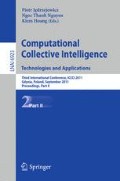Abstract
Due to the intrinsic ambiguity of a natural language the word sense disambiguation or WSD is a challenging task. The paper uses WordNet for (WSD) for that purpose. Unlike many others approaches on that area it exploits the structure of WordNet in an indirect manner. To disambiguate the words it measures the semantic similarity of the words glosses. The similarity is calculated using the SynPath algorithm. Its essence is the replacement of each word by a sequence of WordNet synset identifiers that describe related concepts. To measure the similarity of such sequence the standard tf-idf formula is used. At the last stage a modification of Ant Colony Optimization for the Traveling Salesman Problem is responsible for word disambiguation.
Access this chapter
Tax calculation will be finalised at checkout
Purchases are for personal use only
Preview
Unable to display preview. Download preview PDF.
References
Fellbaum, C., Palmer, M.: Manual and Automatic Semantic Annotation with WordNet. In: Proceedings of NAACL 2001 Workshop (2001)
Ng, H.T., Lim, C., Foo, S.: A Case Study on Inter-Annotator Agreement for Word Sense Disambiguation. In: Proceedings of the ACL SIGLEX Workshop: Standardizing Lexical Resources (1999)
Xiaohua, Z., Hyoil, H.: Survey of Word Sense Disambiguation Approaches. In: 18th FLAIRS Conference, Clearwater Beach, Florida (May 15-17, 2005)
Navigli, R.: ACM Computing Surveys 41(2), article 10 (2009)
Fellbaum, C.: WordNet: An electronic Lexical Database. MIT Press, Cambridge (1998)
Stevenson, M., Wilks, Y.: The Interaction of Knowledge Sources in Word Sense Disambiguation. Computational Linguistics 27(3), 321–349 (2001)
Magnini, B., Cavaglià, G.: Integrating Subject Field Codes into WordNet. In: International Conference on Language Resources and Evaluation LREC 2000 (2000)
Hastings, P., et al.: Inferring the Meaning of Verbs from Context. In: Proceedings of the Twentieth Annual Conference of the Cognitive Science Society (1998)
Bhattacharya, I., Getoor, L., Bengio, Y.: Unsupervised Sense Disambiguation Using Bilingual Probabilistic Models. In: Proceedings of the Annual Meeting of ACL (2004)
Agirre, E., et al.: Combining Supervised and Unsupervised Lexical Knowledge Methods for Word Sense Disambiguation. Kluwer Academic Publishers, Dordrecht (1999)
Mihalcea, R., Moldovan, D.: An Iterative Approach to Word Sense Disambiguation. In: Proceedings of Flairs 2000, Orlando, FL, pp. 219–223 (2000)
Kwong, O.Y.: Word Sense Selection in Texts: An Integrated Model, Doctoral Dissertation, University of Cambridge (2000)
Seco, N., Veale, T., Hayes, J.: An Intrinsic Information Content Metric for Semantic Similarity in WordNet. In: Proceedings of the European Conference of Artificial Intelligence (2004)
Mihalcea, R., Corley, C., Strapparava, C.: Corpus-based and Knowledge-based Measures of Text Semantic Similarity. American Association for Artificial Intelligence, 775–780 (2006)
Siemiński, A.: Verifying Text Similarity Measures for Two Layered Retrieval. In: Advances in Multimedia and Network Information System Technologies, pp. 245–256 (2010)
Salton, G., Wong, A., Yang, C.S.: A vector space model for automatic indexing. Communications of the ACM 18(11), 613–620 (1975)
Manning, C., Raghavan, P., Schütze, H.: An Introduction to Information Retrieval. Cambridge University Press, Cambridge (2008)
Dorigo, M.: Optimization, Learning and Natural Algorithms, PhD thesis, Politecnico di Milano, Italie (1992)
Dorigo, M., Stuetzle, T.: Ant Colony Optimization: Overview and Recent Advances, IRIDIA – Technical Report Series (2009) ISSN 1781-3794
Chirico, U.: A Java Framework for Ant Colony Systems. In: Ants 2004: Forth International Workshop on Ant Colony Optimization and Swarm Intelligence, Brussels (2004)
Author information
Authors and Affiliations
Editor information
Editors and Affiliations
Rights and permissions
Copyright information
© 2011 Springer-Verlag Berlin Heidelberg
About this paper
Cite this paper
Siemiński, A. (2011). WordNet Based Word Sense Disambiguation. In: Jędrzejowicz, P., Nguyen, N.T., Hoang, K. (eds) Computational Collective Intelligence. Technologies and Applications. ICCCI 2011. Lecture Notes in Computer Science(), vol 6923. Springer, Berlin, Heidelberg. https://doi.org/10.1007/978-3-642-23938-0_41
Download citation
DOI: https://doi.org/10.1007/978-3-642-23938-0_41
Publisher Name: Springer, Berlin, Heidelberg
Print ISBN: 978-3-642-23937-3
Online ISBN: 978-3-642-23938-0
eBook Packages: Computer ScienceComputer Science (R0)

